MARIANI’S
Virtual
Gourmet
September 17,
2017
NEWSLETTER
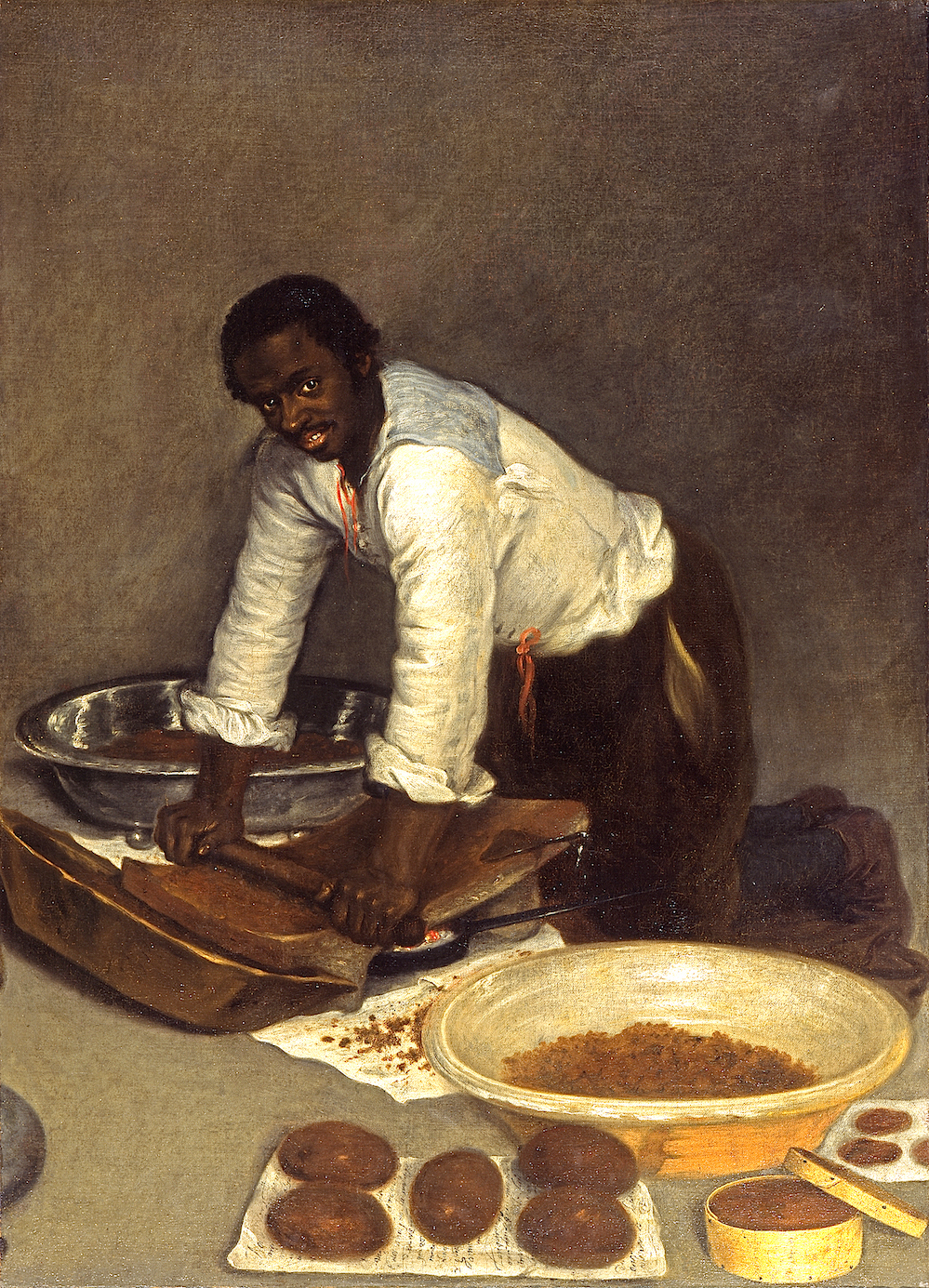
❖❖❖
IN THIS ISSUE
MILAN, Part One
By Misha Mariani
NEW YORK CORNER
GÜNTHER SEEGER NY
By John Mariani
NOTES FROM THE WINE CELLAR
SPICES ARE SO UNKIND TO WINES
By John Mariani
❖❖❖
MILAN
Part One
By Misha Mariani
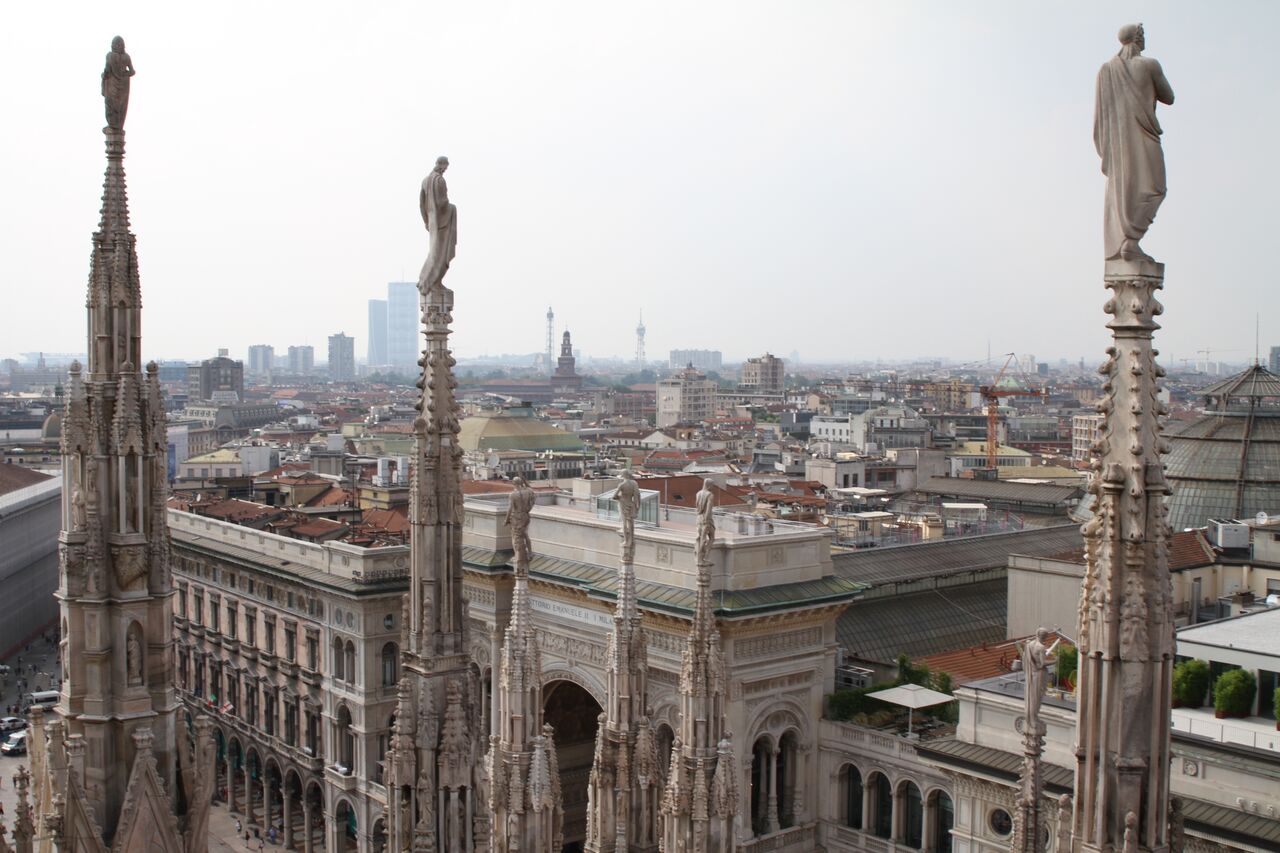
View of Milan from the top of the Duomo (2017) photo by Misha Mariani
So
it was Day 13 of two weeks of travel spanning
the Italian and French Rivieras, beginning and
ending in Milan, which is a far cry from the
beaches in small villages like Camogli and
Portofino and the hills of Saint Tropéz. Thus,
our last day in Europe was a way to settle back
into urban sophistication after the more idyllic
charms of the Rivieras.
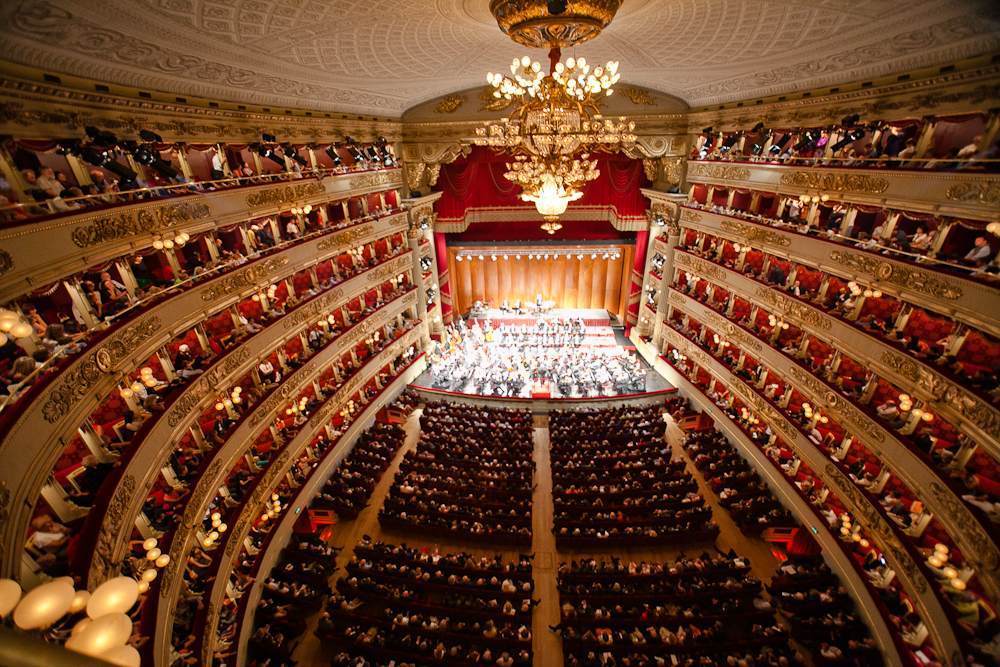 Not too
long ago Milan endured an image of being a
northern industrial city, but today the first
thing that comes to mind when the city’s name is
uttered is fashion. Milan Fashion Week is one of
the most prestigious, highly attended and
influential weeks of the year for the fashion
industry, when the greatest designers gather to
show off their upcoming collections that will
shape and dictate the styles to come. In this
century Milan has surpassed Paris as the fashion
capital of the world. But Milan is not
solely about fashion. It is a city that leads
Italy in so many important ways, not least as
Italy’s financial center, where its Stock Exchange
is located. In the arts Milan sets the standards
and the tone for other major European markets. The
city is home to one of the grandest Opera houses
in the world, Teatro
della Scala (left). It is the city where
Leonardo DaVinci’s “Last Supper” and the Brera Museum
are located, anchored by the Gothic Milan
Cathedral and the Galleria, the world’s first
shopping mall. And let’s not forget, Milan has
some of the most exclusive shopping in Europe.
Not too
long ago Milan endured an image of being a
northern industrial city, but today the first
thing that comes to mind when the city’s name is
uttered is fashion. Milan Fashion Week is one of
the most prestigious, highly attended and
influential weeks of the year for the fashion
industry, when the greatest designers gather to
show off their upcoming collections that will
shape and dictate the styles to come. In this
century Milan has surpassed Paris as the fashion
capital of the world. But Milan is not
solely about fashion. It is a city that leads
Italy in so many important ways, not least as
Italy’s financial center, where its Stock Exchange
is located. In the arts Milan sets the standards
and the tone for other major European markets. The
city is home to one of the grandest Opera houses
in the world, Teatro
della Scala (left). It is the city where
Leonardo DaVinci’s “Last Supper” and the Brera Museum
are located, anchored by the Gothic Milan
Cathedral and the Galleria, the world’s first
shopping mall. And let’s not forget, Milan has
some of the most exclusive shopping in Europe.
On our
return to the city for our last night, my wife and
I stayed at the Mandarin
Oriental Milan. From a narrow cobbled
road we pulled up to the main entrance into the
hotel’s private piazza, which was long ago a cart
entry. Today the premises are made up of four
historic 18th century buildings, formerly a
manor house, a bank and the city’s tax office. Via
the vision of architect and designer Antonio
Citterio, the four structures were transformed
into one of the most beautifully modern locations
in the city.
Upon entering the
main lobby, you will easily sense Citterio’s
particular style, dimora Milanese—“noble Milanese
residence”—by which the design of the façade was
kept in tune with much of Milan’s architectural
motifs; inside, the design is driven more by
modernity central to the Mandarin Oriental group’s
style. This blend of old and new is exemplified by
Citterio’s use of highly colorful palettes,
beautiful oak 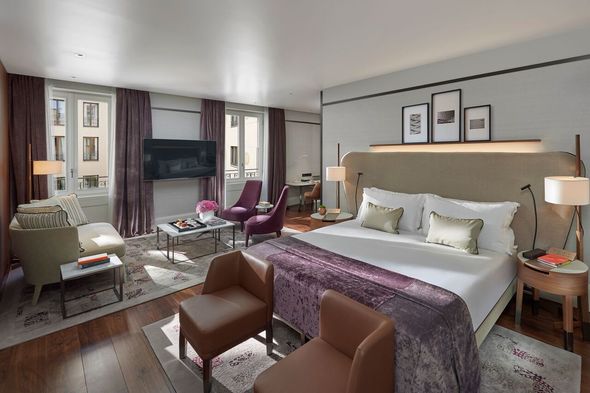 wood
floors, Italian and Brazilian marble, walnut and
oak walls, and soft textures of velvet that meld
with and complement harder lines throughout the
décor, which differs in each room. There are a
number of suites inspired by great Milanese
designers whom Citterio considers masters,
including The Fornasetti Suite, which is playful,
full of visual textures, and a departure from the
rest. Another is an homage to Giò Ponti, which
takes a 1950s minimalist approach highlighted by a
Sarfatti chandelier, vases by Christofle, arm
chairs and sofas designed by L. Caccia Dominioni,
and the ‘Spoon XL’ bathtub from Agape.
wood
floors, Italian and Brazilian marble, walnut and
oak walls, and soft textures of velvet that meld
with and complement harder lines throughout the
décor, which differs in each room. There are a
number of suites inspired by great Milanese
designers whom Citterio considers masters,
including The Fornasetti Suite, which is playful,
full of visual textures, and a departure from the
rest. Another is an homage to Giò Ponti, which
takes a 1950s minimalist approach highlighted by a
Sarfatti chandelier, vases by Christofle, arm
chairs and sofas designed by L. Caccia Dominioni,
and the ‘Spoon XL’ bathtub from Agape.
As someone who has traveled
through much of Europe, Japan and the continental
U.S., staying in a number of Mandarin Oriental
properties, I have always noticed the consistency
and continuity of the staff towards their guests.
After
checking
in, we ventured out into the fashion district just
a few blocks away to work up an appetite for
dinner and to 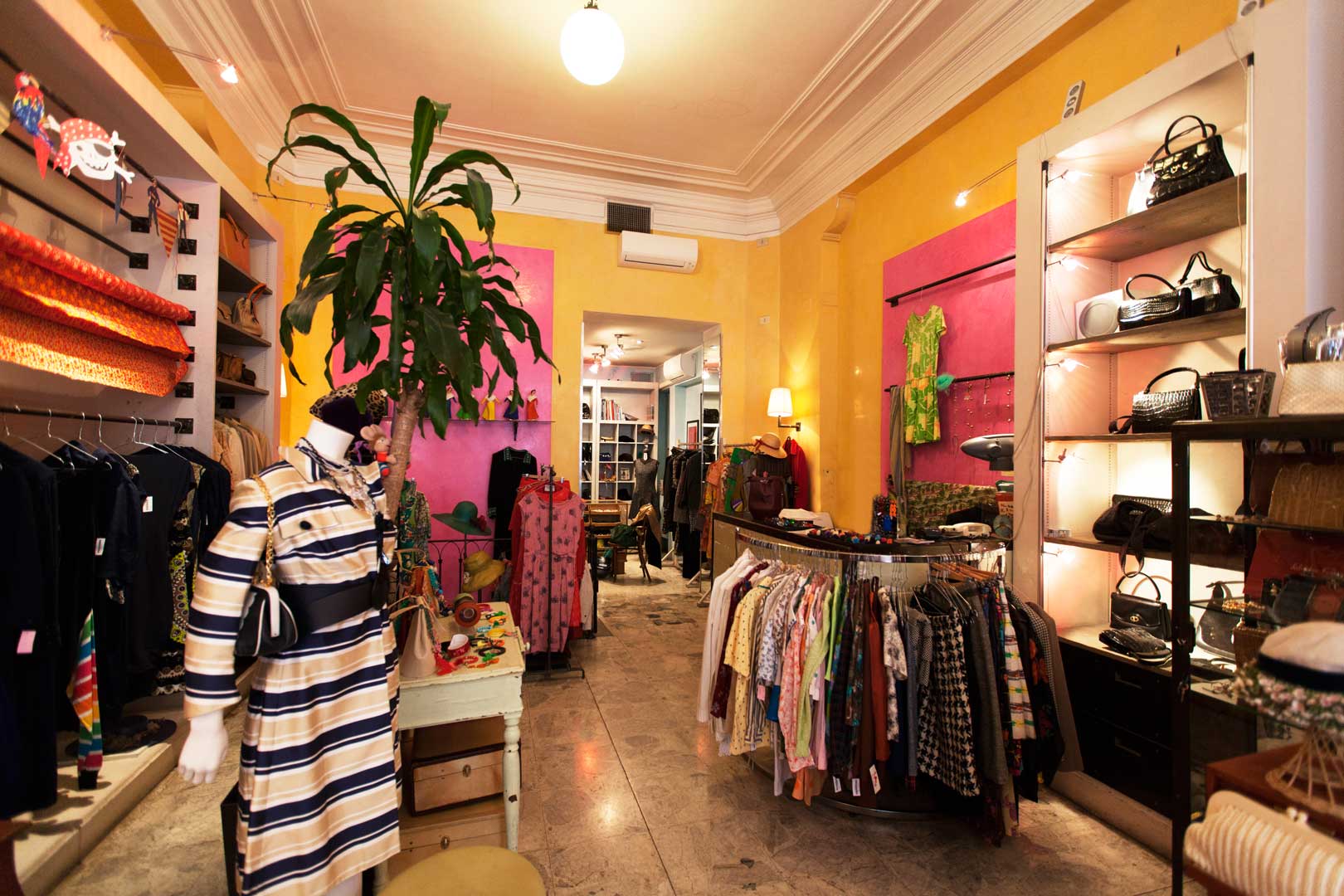 splurge a
little on some high-end fashion. We of course hit
the main shops in the so-called Golden
Triangle—the cobbled streets of Via della Spiga,
Via Santa Andrea and Via Montenapoleone lined with
boutiques by Alexander McQueen, Thom Browne, Luis
Vuitton and Gianvito Rossi—but we also stumbled
across a great vintage couture shop named Cavalli e Nastri
(right)
where my wife found an Yves St. Laurent bag going
back 20 years and a supple white lamb’s leather
Fendi jacket.
splurge a
little on some high-end fashion. We of course hit
the main shops in the so-called Golden
Triangle—the cobbled streets of Via della Spiga,
Via Santa Andrea and Via Montenapoleone lined with
boutiques by Alexander McQueen, Thom Browne, Luis
Vuitton and Gianvito Rossi—but we also stumbled
across a great vintage couture shop named Cavalli e Nastri
(right)
where my wife found an Yves St. Laurent bag going
back 20 years and a supple white lamb’s leather
Fendi jacket.
By the way, in an effort to
attract more visitors, Milan has banned all street
food, food trucks, and drinks in glass bottles in
heavily trafficked parts of the city, including
the area between Piazza XXIV Maggio, Gorizia
Avenue, Via Codara, Cantore Square, and Gabriele
D’Annunzio Avenue, as well as fireworks and
firecrackers, and selfie sticks!
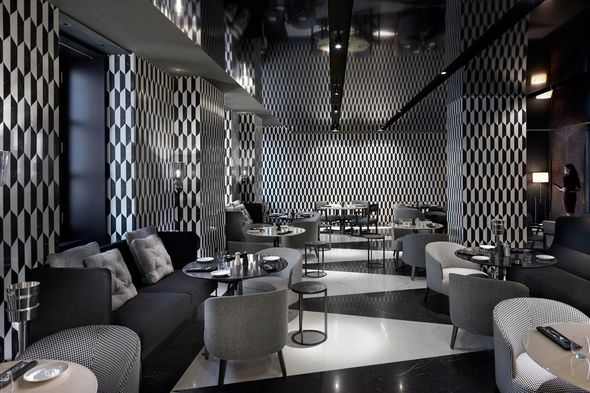 After a couple hours of
shopping, I was ready to throw in the towel, so we
headed back to our room to get ready for what was
to become the best meal we had on our entire
journey over the two weeks in Europe. I guess
they’re right when they say you save the best for
last. There are two restaurants, the casual
Mandarin Bar & Bistro (left)and the
elegant Seta, both overseen by Executive Chef
Antonio Guida (below,
left), who has an extensive history,
working in his earlier years for Pierre Gagnaire
in Paris, Enoteca Pinchiorri in Florence and Don
Alfonso on the Amalfi Coast. Upon his joining Seta
(below),
the restaurant received its first Michelin star,
after only four months of being open, and then in
2016 received its second star—one of only five
restaurants in Milan so ranked.
After a couple hours of
shopping, I was ready to throw in the towel, so we
headed back to our room to get ready for what was
to become the best meal we had on our entire
journey over the two weeks in Europe. I guess
they’re right when they say you save the best for
last. There are two restaurants, the casual
Mandarin Bar & Bistro (left)and the
elegant Seta, both overseen by Executive Chef
Antonio Guida (below,
left), who has an extensive history,
working in his earlier years for Pierre Gagnaire
in Paris, Enoteca Pinchiorri in Florence and Don
Alfonso on the Amalfi Coast. Upon his joining Seta
(below),
the restaurant received its first Michelin star,
after only four months of being open, and then in
2016 received its second star—one of only five
restaurants in Milan so ranked.
The Bar & Bistro is done in
a sophisticated decor of hound’s tooth patterned
furniture and a mosaic of black and white marble
décor that goes from floor to ceiling along the
walls and pillars. Cocktails and light dishes are
served. Seta’s design has plush, opulent fabrics,
vibrant deep colors, and glorious woods with 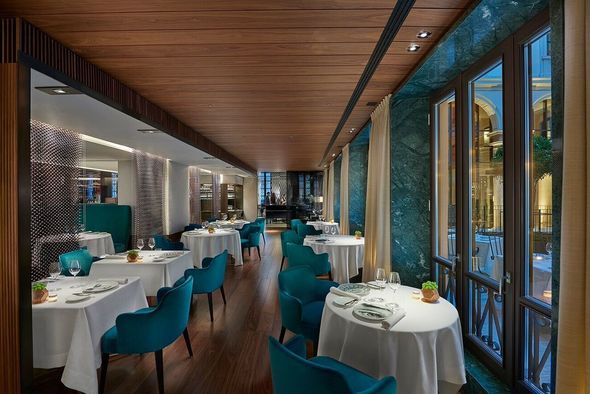 crisp white tablecloths
and aquamarine veined marble laminates. In the
mood for a culinary adventure, we left ourselves
in the hands of Chef Guida—resulting in a
seven-course journey of modern Italian cuisine,
beginning with ostriche
con patate, peperoni frigitelli e salsa alla
champagne, a succulent oyster just barely
poached enough to tighten its texture, set over
gently crushed potatoes and draped with a velvety
Champagne sauce. Following this was astice blu arrosto
con zabaione ai funghi, cardi e polvere di
trombette, pan-roasted blue lobster with
a zabaione of earthy mushrooms and tart cardoons
to balance the essential sweetness of the lobster.
Riso in cagnone
con verdure, Maccagno e polvere di lampone was
one of my favorite dishes of the meal: perfectly
al dente risotto was made with Maccagno, a
half-cooked cow’s milk cheese from Piedmont that
crisp white tablecloths
and aquamarine veined marble laminates. In the
mood for a culinary adventure, we left ourselves
in the hands of Chef Guida—resulting in a
seven-course journey of modern Italian cuisine,
beginning with ostriche
con patate, peperoni frigitelli e salsa alla
champagne, a succulent oyster just barely
poached enough to tighten its texture, set over
gently crushed potatoes and draped with a velvety
Champagne sauce. Following this was astice blu arrosto
con zabaione ai funghi, cardi e polvere di
trombette, pan-roasted blue lobster with
a zabaione of earthy mushrooms and tart cardoons
to balance the essential sweetness of the lobster.
Riso in cagnone
con verdure, Maccagno e polvere di lampone was
one of my favorite dishes of the meal: perfectly
al dente risotto was made with Maccagno, a
half-cooked cow’s milk cheese from Piedmont that 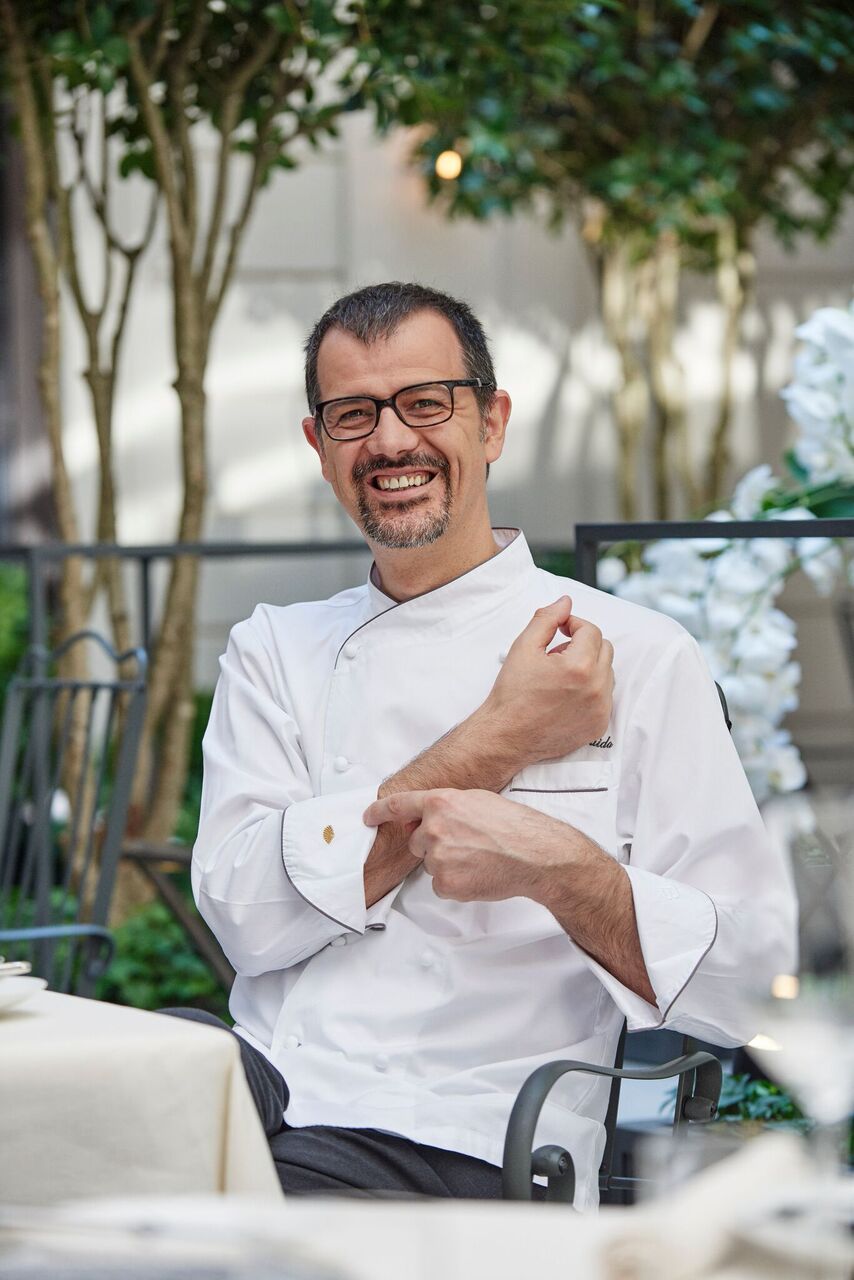 has hints of herbs in its profile to
complement the autumn vegetable style of
vegetable-based risotto, finished with a dash of
raspberry powder that added a kick of acidity
perfectly balancing the richness of the dish.
has hints of herbs in its profile to
complement the autumn vegetable style of
vegetable-based risotto, finished with a dash of
raspberry powder that added a kick of acidity
perfectly balancing the richness of the dish.
Though not my favorite,
spaghetti with a very pungent mackerel sauce
topped with a julienne of cuttle fish was
impeccably executed, and if you like those pungent
flavors, then make it a point not to miss it. Triglia avvolta in
foglie di bieta, salsa di granciporro e
conchiglie di mare was my second
favorite dish that evening: beautiful whole red
mullet cooked till just medium, finished with a
king crab sauce similar to sauce Américaine, then
garnished with tender morsels of sea snails that
added just one more dimension.
Our
final savory course was loin of lamb roasted to
its rightful rosy state, complemented with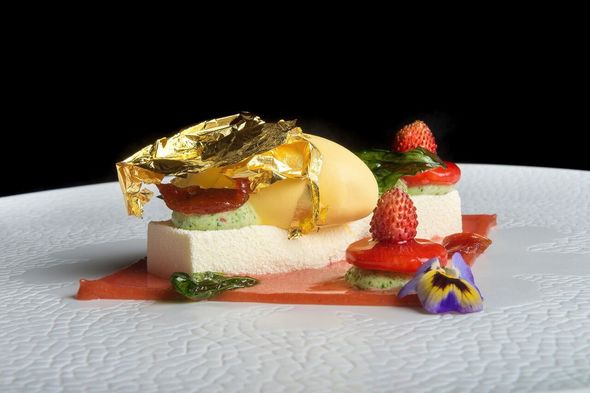 small eggplants and
finished with creamy goat’s cheese. Last but not
least was dessert, a course that should carry just
as much importance as any other course (as I am
always reminded by my wife, who is pastry chef
under Marc Aumont in New York’s Gabriel Kreuther
Restaurant). Our culinary excursion concluded with
dolce alla ricotta, cheesecake with wild
strawberries, a tomato water sauce and saffron ice
cream (right).
small eggplants and
finished with creamy goat’s cheese. Last but not
least was dessert, a course that should carry just
as much importance as any other course (as I am
always reminded by my wife, who is pastry chef
under Marc Aumont in New York’s Gabriel Kreuther
Restaurant). Our culinary excursion concluded with
dolce alla ricotta, cheesecake with wild
strawberries, a tomato water sauce and saffron ice
cream (right).
Seta’s wine list is extensive,
to say the least, but if you plan on doing a
multiple course experience, I recommend entrusting
yourself to the wine team and have them do a
dish-by-dish pairing for you, as I did. Their
services were thoughtful, unique, engaging and
elevating.
So
following what was one of the most inspiring
meals of our trip, I surrendered to the
sentiment that Milan had become one of my favorite
cities in Italy. I had come to the realization
that Milan wasn’t just the superficial fashion
town I had always assumed but was a city
incredibly rich in art,culture and style. It is a
diverse city, and one that can satisfy the
yearning of many different people from many walks
of life.
❖❖❖
By John Mariani
GÜNTER SEEGER
ONE YEAR LATER
By John Mariani
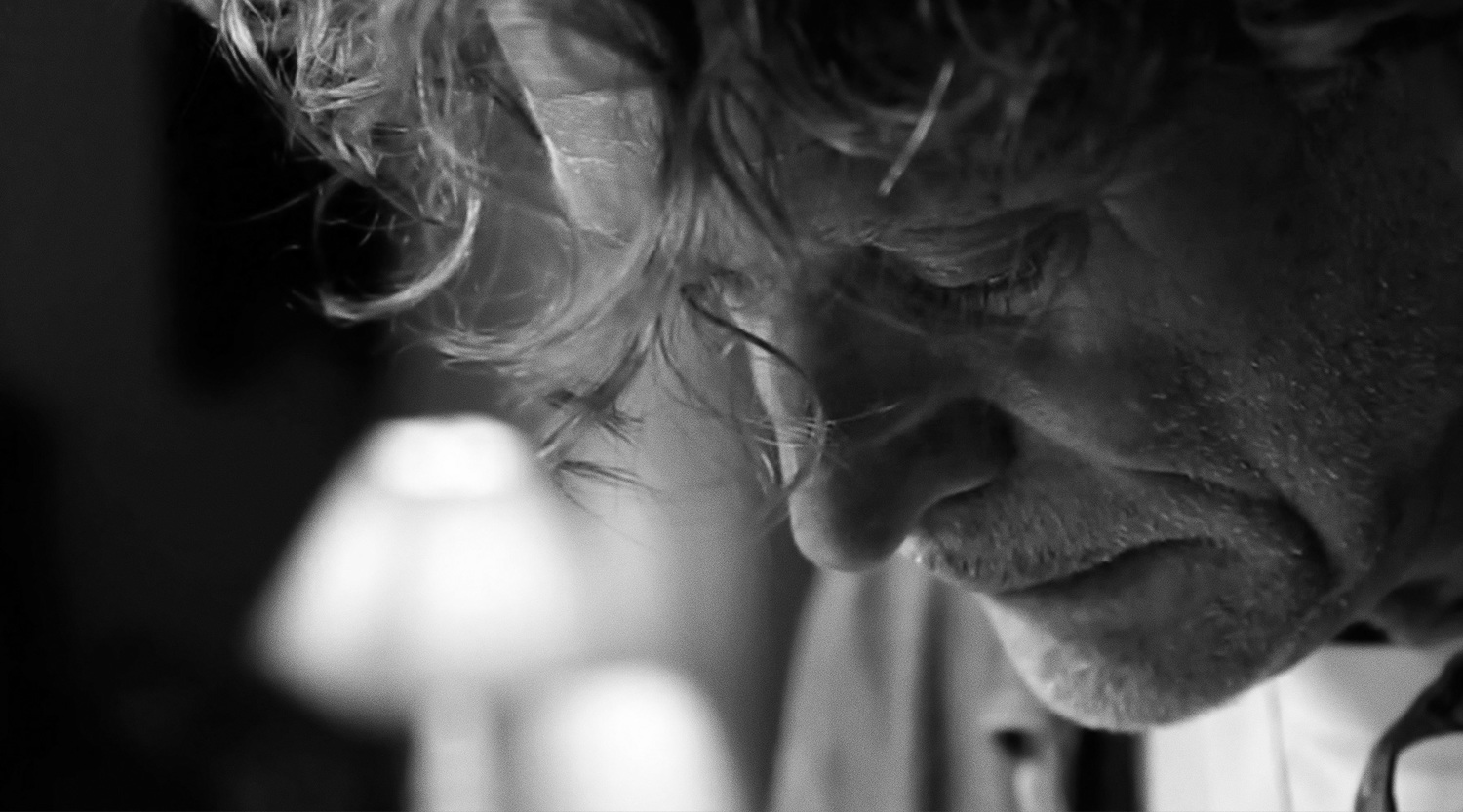
When I last wrote about Günter Seeger’s namesake restaurant, he had recently garnered his first Michelin star, which only caused him to tell me, “Now we want to get better and better and better.” On the basis of a recent meal at his beautiful dining room in the Meatpacking District in Lower Manhattan, he has clearly kept his promise.
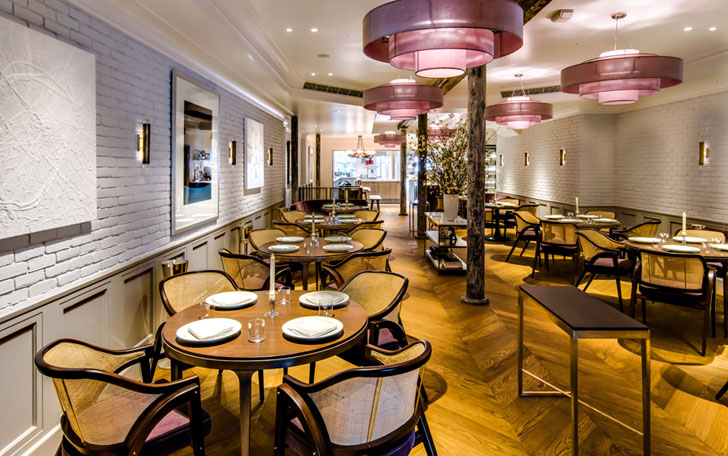 I’ve known Seeger and his
cuisine since he was chef at the Ritz-Carlton in
Atlanta and then opened his own restaurant there,
earning my pick in Esquire
magazine as Restaurant of the Year in 1998.
Born and raised in Germany’s Black Forest, Seeger
arrived in Atlanta in 1985, to a city not quite
ready for long, personalized tasting menus of
classic and nouvelle European cuisine. He left
Atlanta in 2007, did consulting out of NYC and
finally opened his dream restaurant a year and a
half ago on Hudson Street, where he again offered
only a $185 nine-course tasting meal. Yet, despite
some excellent reviews, business was slow, so that
he changed the menu format to offer ten
I’ve known Seeger and his
cuisine since he was chef at the Ritz-Carlton in
Atlanta and then opened his own restaurant there,
earning my pick in Esquire
magazine as Restaurant of the Year in 1998.
Born and raised in Germany’s Black Forest, Seeger
arrived in Atlanta in 1985, to a city not quite
ready for long, personalized tasting menus of
classic and nouvelle European cuisine. He left
Atlanta in 2007, did consulting out of NYC and
finally opened his dream restaurant a year and a
half ago on Hudson Street, where he again offered
only a $185 nine-course tasting meal. Yet, despite
some excellent reviews, business was slow, so that
he changed the menu format to offer ten
The dining room,
with a separate section off the open kitchen, has
also become a warmer, more inviting spot, with blond
wooden floors, a lovely chandelier said to be
Seeger’s grandmother’s, marvelous effusions of
flowers, and wooden beams and columns that echo
Seeger’s Black Forest childhood. The stemware is of
exquisite quality, and the bare tables are made of
very beautiful dark wood. Conversation in a full
room is easy; men are requested to wear jackets and
women tend to dress up; the exceptionally cordial
service staff is equally well dressed in black and
white. The wine list is world class, with an
admirable emphasis on German bottlings, which are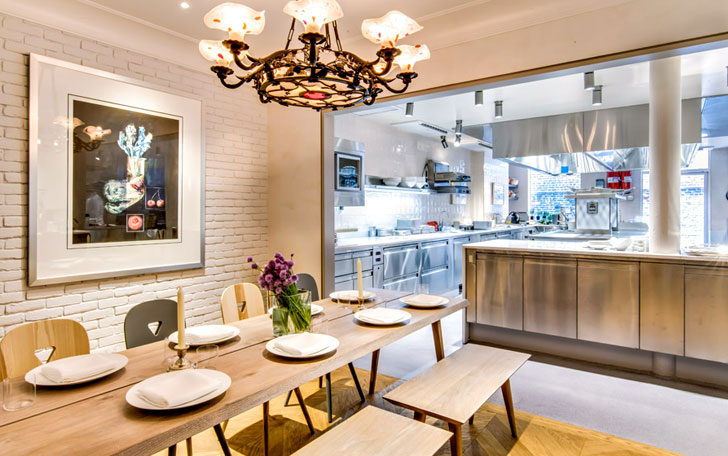
I told the captain that my
wife and I would rather not both have the
His amuse of a
gently steamed egg with a maple Chantilly cream and
smoked trout roe (below)
has become something of a signature that proclaims
that everything to follow will have the same simple
presentation, color, and imaginative playfulness. It
was served with a glass of Equipo Navazos Sherry La
Bota de Amontillado. Next came marinated
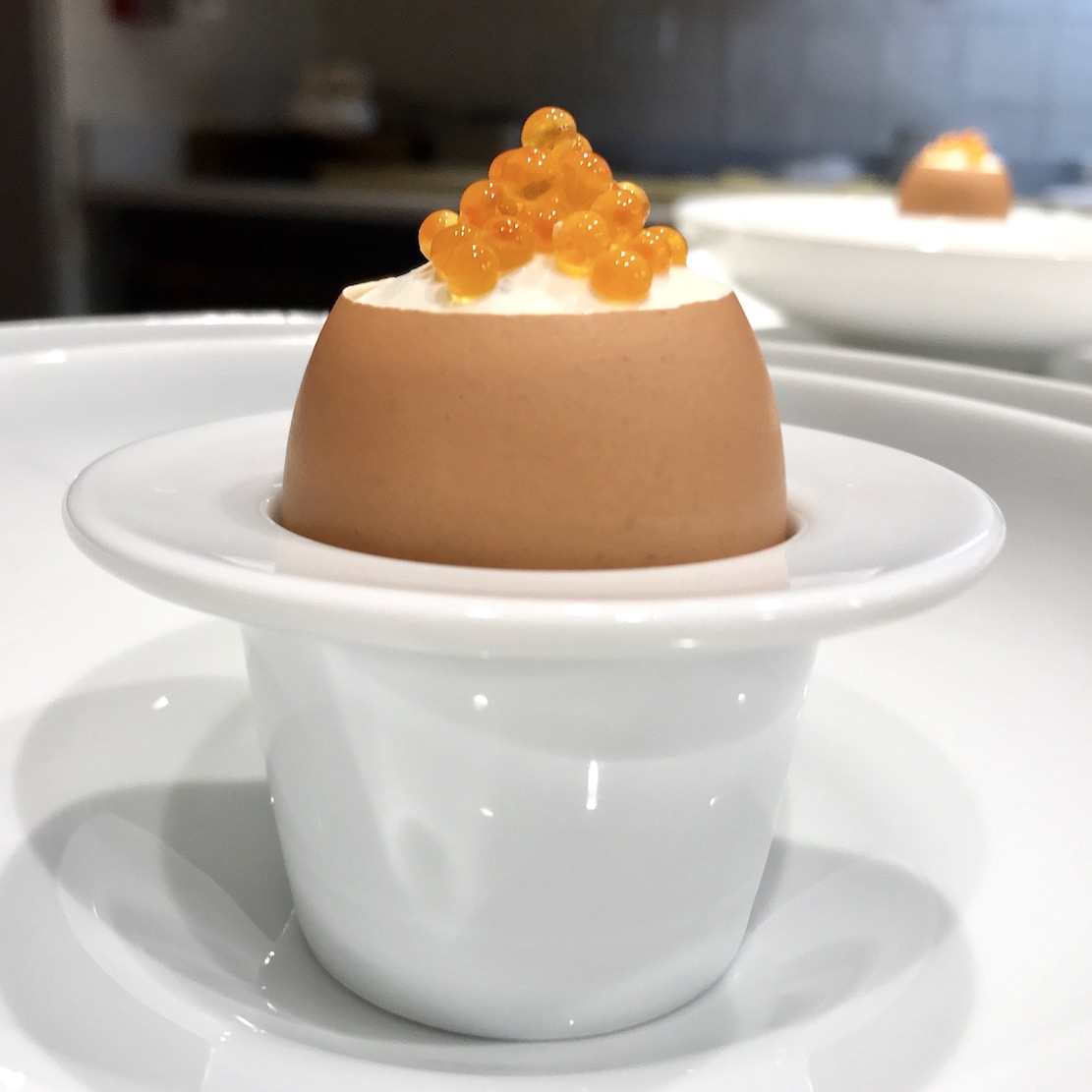 Adirondack
Mountain
trout came with nothing more than braised gem
Adirondack
Mountain
trout came with nothing more than braised gem
After all these
delicacies, it made sense to serve beef tenderloin,
with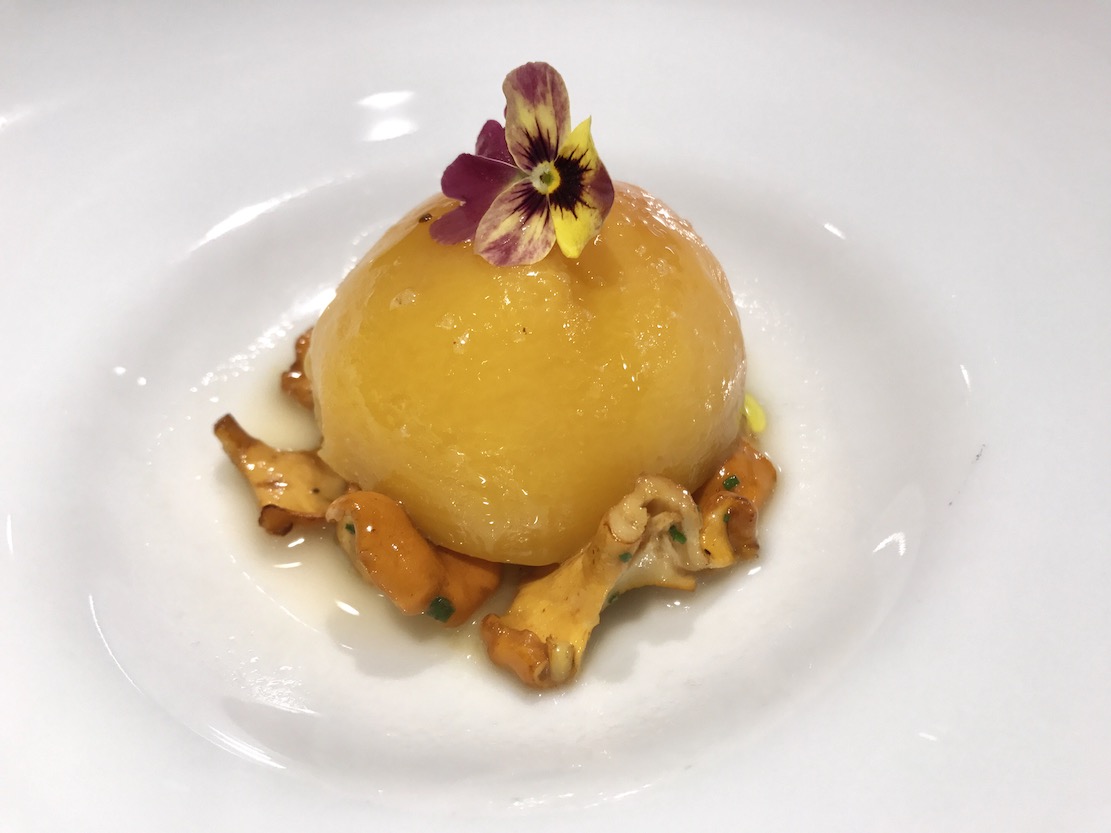 ‘La
Moussière’ Sancerre. The small surprise to end the
meal was a
‘La
Moussière’ Sancerre. The small surprise to end the
meal was a
At
the end of such a grand evening, my wife and I had
three reactions:
641 Hudson Street (near Gansevoort
Street)
646-657- 0045
❖❖❖
WHEN IT COMES TO SPICE,
IT'S NOT SO NICE WITH WINE
By John Mariani
 Julia
Child
once remarked that you can’t have a great
cuisine without wine, and, however obtuse that
seems, an underlying question remains: What
exactly do you serve with highly spiced food
from countries like China, Korea, Thailand and
India? Is there really a wine that holds up
well with Texas chili or Nashville hot
chicken? And is there really any rationale
always to try to match wine to a dish rather
than drink what the locals do with their
cuisine?
Julia
Child
once remarked that you can’t have a great
cuisine without wine, and, however obtuse that
seems, an underlying question remains: What
exactly do you serve with highly spiced food
from countries like China, Korea, Thailand and
India? Is there really a wine that holds up
well with Texas chili or Nashville hot
chicken? And is there really any rationale
always to try to match wine to a dish rather
than drink what the locals do with their
cuisine?
This thought occurred to
me—not for the first time—at a wine dinner in
The Grill in New York City that seemed to
promise careful match-ups of the featured wines
with foods that would complement, but not
overpower, them. The wines were from Spain’s
Viña Ardanza, which produces Tempranillo-based
Riojas of consummate refinement and rich
complexity. One of the dishes served, however,
was a large, medium-rare filet mignon au poivre—that
classic French bistro dish of such pungency that
any wine chosen will be nothing more than a
beverage. This version of the dish was so
heavily massed with crushed black peppercorns
that they emerged as the main flavor, so that
the beautiful Viña Ardanza was obliterated by
it. Had the filet mignon been
served unadulterated by the pepper, it indeed
would have complemented the flavors of the wine,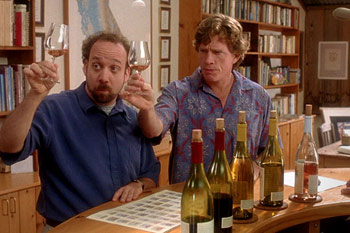 as would any red meat served
simply. But it seems obvious that you should not
serve a wine like Viña Ardanza with Sichuan
dried beef, lamb vindaloo or Korean barbecued
beef with kim
chee. It would be like wearing an
elegant little black dress underneath a studded
biker jacket (which I suppose in some quarters
might seem edgy).
as would any red meat served
simply. But it seems obvious that you should not
serve a wine like Viña Ardanza with Sichuan
dried beef, lamb vindaloo or Korean barbecued
beef with kim
chee. It would be like wearing an
elegant little black dress underneath a studded
biker jacket (which I suppose in some quarters
might seem edgy).
There
are
also some non-spicy foods that literally make
wines taste unpalatable, like artichokes and
asparagus, despite so many books that insist on
matching every food on Earth with a wine. But,
when we are dealing with high spices and
herbs—chili peppers, certain forms of black
pepper, liberal use of cinnamon, strong mustard,
cardamom, asafetida,
garam masala, cumin, soy sauce, wasabi, kim chee,
hoisin, nuoc mam fish sauce, even sugar
or honey—wine, which is made solely from grape
juice, cannot enhance, or even hold up, such
flavors.
 Historically, wine always has been
part of Chinese food culture; the Jesuits
brought viniculture to Japan in the 16th
century; and the British to India in the 18th
century. But the arrival of the American chile
pepper in the 17th century radically altered
Persian and Asian cuisine, which, blended with
other pungent herbs and spices, led to foods for
which wine—not drunk among the general
populace—found no match. And, despite China’s
and Japan’s nouveau rich appetite for the
highest priced French wines at auction, that is
an anomaly causing Hong King billionaires to
serve $1,000 First Growth Bordeaux with Beijing
duck and $10,000 Romanée-Conti with dishes like
octopus in black bean sauce and sweet-and-sour
lamb.
Historically, wine always has been
part of Chinese food culture; the Jesuits
brought viniculture to Japan in the 16th
century; and the British to India in the 18th
century. But the arrival of the American chile
pepper in the 17th century radically altered
Persian and Asian cuisine, which, blended with
other pungent herbs and spices, led to foods for
which wine—not drunk among the general
populace—found no match. And, despite China’s
and Japan’s nouveau rich appetite for the
highest priced French wines at auction, that is
an anomaly causing Hong King billionaires to
serve $1,000 First Growth Bordeaux with Beijing
duck and $10,000 Romanée-Conti with dishes like
octopus in black bean sauce and sweet-and-sour
lamb.
Some wine writers suggest
that Gewürztraminer from Germany or Alsace is a
good choice with spicy dishes, because the
varietal itself has some spiciness to it. But,
when the full fury of a chile pepper is
unleashed on a Gewürztraminer, the wine’s
characteristics are lost. Others contend that if
spice is tough to match with wine, then choosing
a rather bland white wine like pinot grigio or
pinot blanc makes sense. But then what’s the
point? Still others—the kind of enophiles who
believe Champagne goes with everything—say that
the bubbles and acid in Champagne will “help to
cut the heat” of spicy foods. If so, it’s an
awfully expensive way to go about it, when beer
or sparkling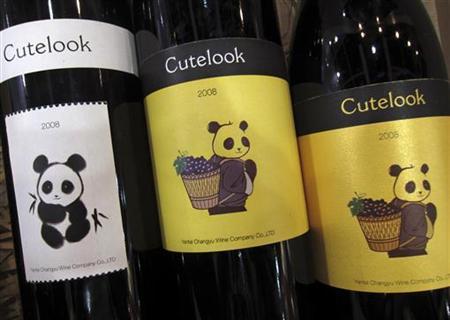 water
is a much better option.
water
is a much better option.
Increasingly,
I
find Chinese and Indian restaurants in America
and Europe stocking wines that might work with
the menu’s offerings—big-bodied reds, bland whites,
even sweet wines like Sauternes or Johannisberg
Riesling. I tend to stick with imported Asian
beers, even if so many of them are made for the
Western palate. But they all work fine with
dishes like pad Thai, rogan josh, samosas, doro watt, and
American dishes that deliberately go off the
heat scale, as in the current fad for hot
chicken doused with chile powder, chili con
carne spiked with any of the fifty hot sauces
lining the eatery’s shelf, or dry-rubbed
barbecue with brown-sugar suffused baked beans
on the side. Nothing’s going to work.
Wine
lovers
have to realize that it’s perfectly okay not to
drink wine with every meal, especially if it
conflicts with the food. Let’s face it, drinking
wine with a glazed donut when you could be
having it with a nice glass of milk or cup of
coffee is a no brainer. So, too, trying to
figure out what wine will go with an item on a
Thai menu with five little chile pepper icons
appended to its name is just plain dumb.
❖❖❖
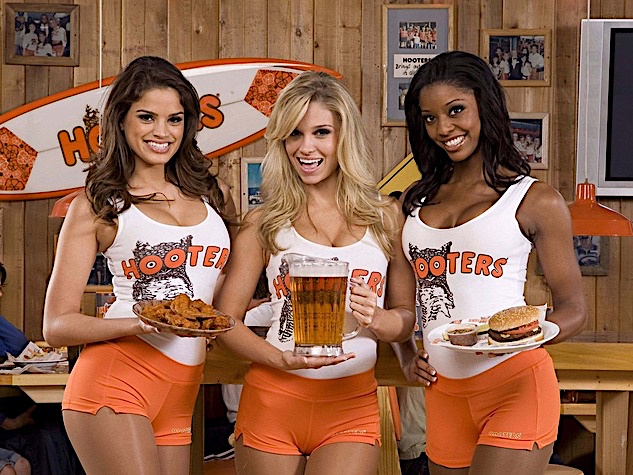 HOW
DO YOU GET A
HOW
DO YOU GET A
GRANT
TO STUDY THAT?
USA
Today reports that researchers concluded
that women who work in “sexually objectifying
restaurant environments” like Hooters and Twin
Peaks, where they must wear revealing clothing and
flirt with customers, were at greater risk for
anxiety and eating disorders. According to the
study "In Sexually Objectifying
Environments: Power, Rumination, and Waitresses’
Anxiety and Disordered Eating" published in Psychology of
Women Quarterly, a pair of researchers surveyed
250 female restaurant servers at such
"breastaurants" and found the in some cases the
women's appearance was “graded” by customers and
supervisors and that the women "lacked power at
work to control their own environment, such as
with sexual harassment."
TRAVEL ARTICLES WE NEVER FINISHED
READING
“A baby elephant seal was making eyes
at me.”—Maggie Shipstead, “The Southern Wild,” Conde Nast Traveler (Aug.
2017).
Any of John Mariani's books below may be ordered from amazon.com.
 The
Hound in Heaven (21st Century Lion Books)
is a novella, and for anyone who loves dogs,
Christmas, romance, inspiration, even the supernatural, I
hope you'll find this to be a treasured favorite.
The story concerns how, after a New England teacher,
his wife and their two daughters adopt a stray puppy found
in their barn in northern Maine, their lives seem full of
promise. But when tragedy strikes, their wonderful dog
Lazarus and the spirit of Christmas are the only things
that may bring his master back from the edge of
despair.
The
Hound in Heaven (21st Century Lion Books)
is a novella, and for anyone who loves dogs,
Christmas, romance, inspiration, even the supernatural, I
hope you'll find this to be a treasured favorite.
The story concerns how, after a New England teacher,
his wife and their two daughters adopt a stray puppy found
in their barn in northern Maine, their lives seem full of
promise. But when tragedy strikes, their wonderful dog
Lazarus and the spirit of Christmas are the only things
that may bring his master back from the edge of
despair. WATCH THE VIDEO!
“What a huge surprise turn this story took! I was completely stunned! I truly enjoyed this book and its message.” – Actress Ali MacGraw
“He had me at Page One. The amount of heart, human insight, soul searching, and deft literary strength that John Mariani pours into this airtight novella is vertigo-inducing. Perhaps ‘wow’ would be the best comment.” – James Dalessandro, author of Bohemian Heart and 1906.
“John Mariani’s Hound in Heaven starts with a well-painted portrayal of an American family, along with the requisite dog. A surprise event flips the action of the novel and captures us for a voyage leading to a hopeful and heart-warming message. A page turning, one sitting read, it’s the perfect antidote for the winter and promotion of holiday celebration.” – Ann Pearlman, author of The Christmas Cookie Club and A Gift for my Sister.
“John Mariani’s concise, achingly beautiful novella pulls a literary rabbit out of a hat – a mash-up of the cosmic and the intimate, the tragic and the heart-warming – a Christmas tale for all ages, and all faiths. Read it to your children, read it to yourself… but read it. Early and often. Highly recommended.” – Jay Bonansinga, New York Times bestselling author of Pinkerton’s War, The Sinking of The Eastland, and The Walking Dead: The Road To Woodbury.
“Amazing things happen when you open your heart to an animal. The Hound in Heaven delivers a powerful story of healing that is forged in the spiritual relationship between a man and his best friend. The book brings a message of hope that can enrich our images of family, love, and loss.” – Dr. Barbara Royal, author of The Royal Treatment.
 |
The Encyclopedia of American Food and Drink by John F. Mariani (Bloomsbury USA, $35) Modesty forbids me to praise my own new book, but let me proudly say that it is an extensive revision of the 4th edition that appeared more than a decade ago, before locavores, molecular cuisine, modernist cuisine, the Food Network and so much more, now included. Word origins have been completely updated, as have per capita consumption and production stats. Most important, for the first time since publication in the 1980s, the book includes more than 100 biographies of Americans who have changed the way we cook, eat and drink -- from Fannie Farmer and Julia Child to Robert Mondavi and Thomas Keller. "This book is amazing! It has entries for everything from `abalone' to `zwieback,' plus more than 500 recipes for classic American dishes and drinks."--Devra First, The Boston Globe. "Much needed in any kitchen library."--Bon Appetit. |
"Eating Italian will never be the same after reading John Mariani's entertaining and savory gastronomical history of the cuisine of Italy and how it won over appetites worldwide. . . . This book is such a tasteful narrative that it will literally make you hungry for Italian food and arouse your appetite for gastronomical history."--Don Oldenburg, USA Today. "Italian
restaurants--some good, some glitzy--far
outnumber their French rivals. Many of
these establishments are zestfully described
in How Italian Food Conquered the World, an
entertaining and fact-filled chronicle by
food-and-wine correspondent John F.
Mariani."--Aram Bakshian Jr., Wall Street
Journal.
"Equal parts
history, sociology, gastronomy, and just
plain fun, How Italian Food Conquered the
World tells the captivating and delicious
story of the (let's face it) everybody's
favorite cuisine with clarity, verve and
more than one surprise."--Colman Andrews,
editorial director of The Daily
Meal.com. "A fantastic and fascinating
read, covering everything from the influence
of Venice's spice trade to the impact of
Italian immigrants in America and the
evolution of alta cucina. This book will
serve as a terrific resource to anyone
interested in the real story of Italian
food."--Mary Ann Esposito, host of PBS-TV's
Ciao
Italia. "John Mariani has written the
definitive history of how Italians won their
way into our hearts, minds, and
stomachs. It's a story of pleasure over
pomp and taste over technique."--Danny Meyer,
owner of NYC restaurants Union Square
Cafe, The Modern, and Maialino.
|
 |
 |
 |
 |
 |
 |
 |
 |
 Everett Potter's Travel Report:
Everett Potter's Travel Report: 
 Eating Las Vegas
JOHN CURTAS has been covering the Las Vegas
food and restaurant scene since 1995. He is
the co-author of EATING LAS VEGAS – The 50
Essential Restaurants (as well as
the author of the Eating Las Vegas web site: www.eatinglasvegas.
He can also be seen every Friday morning as
the “resident foodie” for Wake Up With the
Wagners on KSNV TV (NBC) Channel 3 in
Las Vegas.
Eating Las Vegas
JOHN CURTAS has been covering the Las Vegas
food and restaurant scene since 1995. He is
the co-author of EATING LAS VEGAS – The 50
Essential Restaurants (as well as
the author of the Eating Las Vegas web site: www.eatinglasvegas.
He can also be seen every Friday morning as
the “resident foodie” for Wake Up With the
Wagners on KSNV TV (NBC) Channel 3 in
Las Vegas.

MARIANI'S VIRTUAL GOURMET
NEWSLETTER is published weekly. Editor/Publisher: John
Mariani.
Editor: Walter Bagley. Contributing Writers: Christopher Mariani,
Robert Mariani, Misha Mariani, John A. Curtas, Geoff Kalish, Mort
Hochstein, and
Brian Freedman. Contributing Photographer: Galina
Dargery. Technical Advisor: Gerry McLoughlin.
To un-subscribe from this newsletter,click here.
© copyright John Mariani 2017

